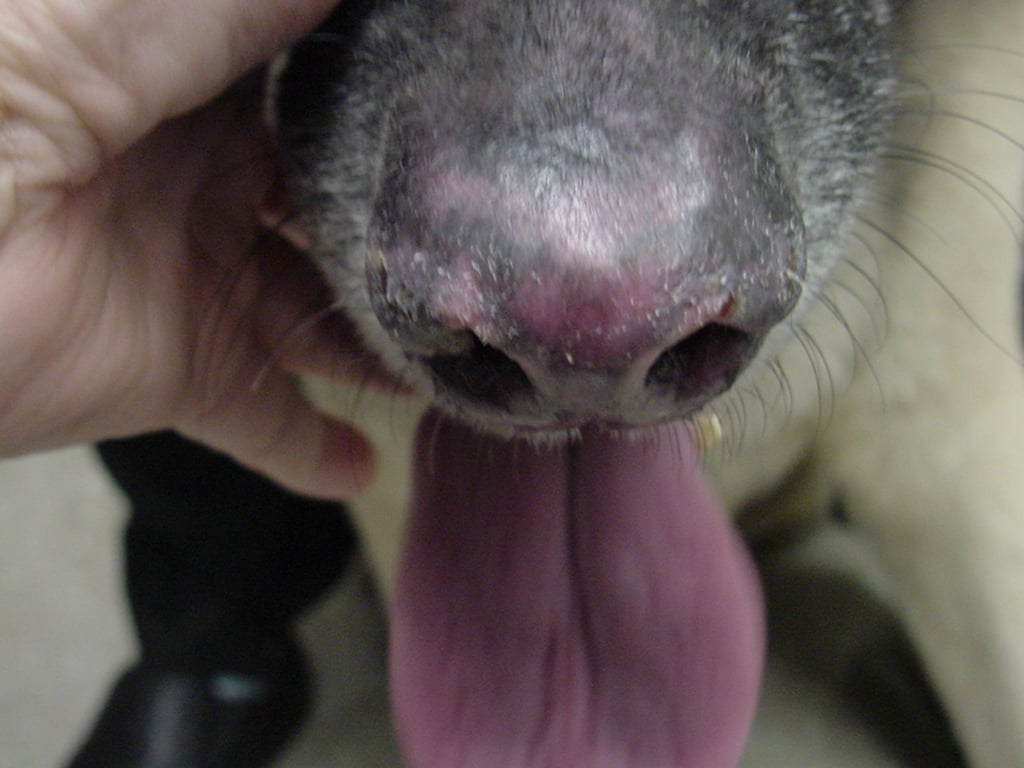Lupus in Dogs
Did you know that man's best friend can also develop skin lupus?

image source: CC BY-SA 3.0 <http://creativecommons.org/licenses/by-sa/3.0/>, via Wikimedia Commons
Lupus is an autoimmune disease that happens when the body’s immune system attacks its own tissues and organs. The inflammation caused by lupus can affect many different areas in the body, including the skin, joints, kidneys, blood cells, brain, heart, and lungs.
Lupus can affect not only humans, but dogs as well. Discoid lupus erythematosus (DLE) is the most common type of cutaneous (skin) lupus in dogs. When dogs develop DLE, it causes them to develop crusting and scabbing of the skin, and hair loss, usually starting around the nose. DLE can also cause the loss of skin pigmentation in the affected area.
DLE happens when the body’s immune system attacks the body and kills a layer of cells within the skin. Environmental factors such as ultraviolet (UV) light and exposure to cigarette smoke appears to trigger or worsen DLE. Genetics also plays a role, and certain dog breeds are more likely to develop DLE, including German Shepherds, Siberian Husky, Chow Chows, Brittany Spaniels, Shetland Sheepdogs, and Alaskan Malamutes.
We collaborated with veterinarians at Tufts Cummings School to examine leftover material from skin biopsies taken to diagnose DLE in pet dogs to better understand what drives disease in both human and veterinary patients. We also compared these samples, which occurred spontaneously, to an inducible mouse model of DLE and to a previously published dataset from human DLE skin. This approach is known as "comparative immunology", meaning comparing immune responses across different organisms, which can help researchers identify important signals in the presence of "noisy" data.
We found 12 immune genes that were highly conserved (meaning the same) in skin samples from humans, dogs and mice. One of our top gene hits was a chemokine called CXCL10, which we have been studying under a research grant award through the Lupus Research Alliance. We hypothesize that these 12 immune genes are strong drivers of DLE.
We also found 18 immune and skin genes that were shared between humans and dogs, which we think represents inflammation in environmentally-triggered DLE (as opposed to induced DLE). You can read our open-access study of canine, human and mouse DLE here.
There are treatments available for dogs suffering from different forms of lupus. Since lupus is an autoimmune disease, treatment requires the suppression of the immune system. Different dogs have different responses to treatment, so a trial-and-error approach is often needed to determine the best treatment for each dog. Treatment may include topical medications, and systemic medications. Like people with lupus, dogs will often need to limit their sun exposure to avoid UV light. They may also require changes in their diet. If veterinarian advice is followed, lupus can be resolved and future recurrences can be avoided.
The results of our study suggest that certain medications that are currently used to treat allergy in dogs might also be used to treat cutaneous lupus. We are excited to help pave the way for development of new treatments for both dogs and people with lupus!
Sources:
Olivry, Linder & Banovic. "Cutaneous lupus erythematosus in dogs: a comprehensive review" BMC Veterinary Research, 2018.
web sources (date last accessed 4/8/21)
https://www.mayoclinic.org/diseases-conditions/lupus/symptoms-causes/syc-20365789#:~:text=Lupus%20is%20a%20systemic%20autoimmune,%2C%20brain%2C%20heart%20and%20lungs.
https://vcahospitals.com/know-your-pet/discoid-cutaneous-lupus-erythematosus#:~:text=Discoid%20lupus%20erythematosus%20is%20the,pigmentation%20in%20the%20affected%20area.
image source: CC BY-SA 3.0 <http://creativecommons.org/licenses/by-sa/3.0/>, via Wikimedia Commons